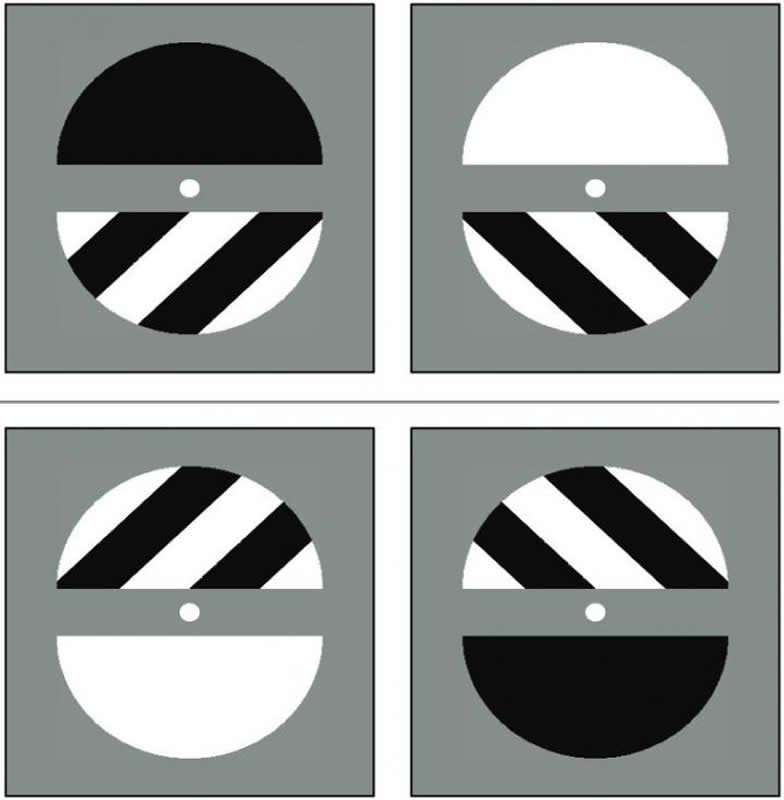Summary: Optical illusions are helping researchers better understand attention and visual perception. Findings suggest attention operates periodically on the perceptual binding of visual information.
Source: University of Tokyo
Rhythmic waves of brain activity cause us to see or not see complex images that flash before our eyes. An image can become practically invisible if it flashes before our eyes at the same time as a low point of those brain waves. We can reset that brain wave rhythm with a simple voluntary action, like choosing to push a button.
The new results come from experts who use optical illusions to understand human vision. Human sight involves activity both in the eyes and in the brain. Optical illusions are formed by playing tricks on any part of our complex visual system.
“This is the first record of rhythmic brain activity used to achieve integrated visual perception,” said Associate Professor Isamu Motoyoshi from the University of Tokyo and co-author of the recent research article.
Reoccurring rhythms of attention and perception
Previous research identified that attention fluctuates six to eight times per second (6 to 8 Hertz), a rate researchers refer to as theta rhythms.
The recent investigation started when Motoyoshi and colleagues were studying the Gabor pattern illusion, in which a smoothly moving circle appears to jump across the screen.
Viewers saw jumps at a constant rhythm regardless of the actual speed of the illusion. The rhythm of jumps in the optical illusion was remarkably similar to the theta rhythm of brain waves related to attention.
“That led us to want to study rhythms of attention and visual perception in more detail,” said Motoyoshi.
Binding form and color in conscious perception
In their recent experiments, researchers asked participants to push a button to begin each trial, whenever they felt ready. Then after some unpredictable wait time, two images would quickly flash on a computer screen, one after the other. Participants then reported which images they saw.

“These tests are considered high cognitive load tasks. You have to identify both the light intensity – white or black color – and the orientation of the image – left or right diagonal lines,” said Ryohei Nakayama, Ph.D., previously a project researcher in Motoyoshi’s lab and a currently a researcher at the University of Sydney, Australia.
You can’t see what you don’t pay attention to
The wait time between the button push and the image flash was between 50 to 800 milliseconds long. In that length of time, theta rhythm brain waves can fluctuate four to seven times.
Participants were much more likely to report correctly which images they saw when the images flashed at the same time as a high point of their attention brain waves, as measured by an EEG (electroencephalogram). The opposite was also true: Participants were more likely to give an incorrect answer when the images were flashed at the same time as a low point of their attention brain wave.
Theoretically, an image could become functionally invisible if it always flashed in time with the low points of theta rhythm attention brain waves.
“Under certain conditions, attention is needed to achieve unified perception. That’s the classic story,” said Motoyoshi.
“But, it is unlikely that one specific brain region is important for attention. Instead, we think the new story is that periodic rhythmic waves of brain activity are required for both visual perception and attention,” he continued.
Motoyoshi and Nakayama hope that their ongoing visual perception research will continue to reveal the complexities of consciousness.
Source:
University of Tokyo
Media Contacts:
Caitlin Devor – University of Tokyo
Image Source:
The image is credited to Nakayama and Motoyoshi 2019.
Original Research: Closed access
“Attention periodically binds visual features as single events depending on neural oscillations phase-locked to action”. Ryohei Nakayama and Isamu Motoyoshi.
Journal of Neuroscience. doi:10.1523/JNEUROSCI.2494-18.2019
Abstract
Attention periodically binds visual features as single events depending on neural oscillations phase-locked to action
Recent psychophysical studies have demonstrated that periodic attention in the 4-8 Hz range facilitates performance on visual detection. The present study examined the periodicity of feature binding — another major function of attention — in human observers (3 females and 5 males for behavior, with 7 males added for the EEG experiment). In a psychophysical task, observers reported a synchronous pair of brightness (light/dark) and orientation (clockwise/counterclockwise) patterns from two combined brightness-orientation pairs presented in rapid succession. We found that temporal binding performance exhibits periodic oscillations at ∼8 Hz as a function of stimulus onset delay from a self-initiated button press in conditions where brightness-orientation pairs were spatially separated. However, as one would expect from previous studies on pre-attentive binding, significant oscillations were not apparent in conditions where brightness-orientation pairs were spatially superimposed. EEG results, while fully compatible with behavioral oscillations, also revealed a significant dependence of binding performance across trials on pre-stimulus neural oscillatory phases within the corresponding band. The peak frequency of this dependence was found to be correlated with inter-trial phase coherence (ITPC) around the timing of button press in parietal sensors. Moreover, the peak frequency of the ITPC was found to predict behavioral frequency in individual observers. Together, these results suggest that attention operates periodically (at ∼8 Hz) on the perceptual binding of multimodal visual information and is mediated by neural oscillations phase-locked to voluntary action.
SIGNIFICANCE STATEMENT
Recent studies in neuroscience suggest that the brain’s attention network operates rhythmically at 4—8 Hz. The present behavioral task revealed that attentional binding of visual features is performed periodically at ∼8 Hz, and EEG analysis showed a dependence of binding performance on pre-stimulus neural oscillatory phase. Furthermore, this association between perceptual and neural oscillations is triggered by voluntary action. Periodic processes driven by attention appear to contribute not only to sensory processing but also to the temporal binding of diverse information into a conscious event synchronized with action.






